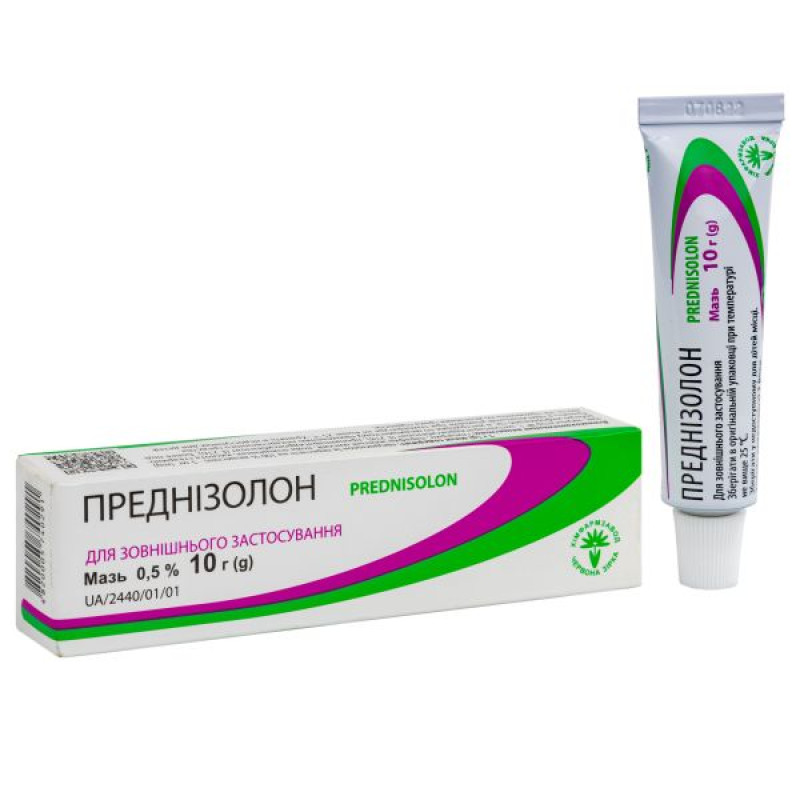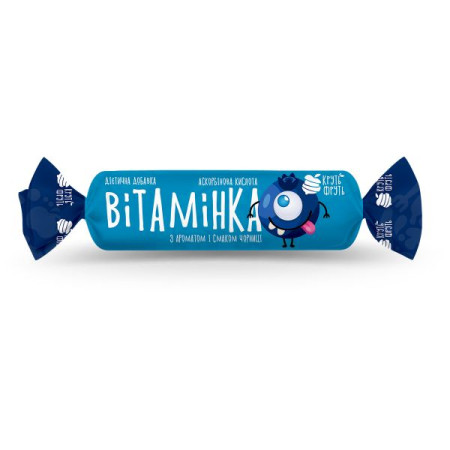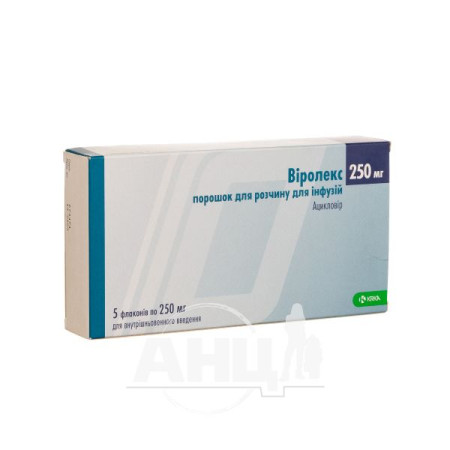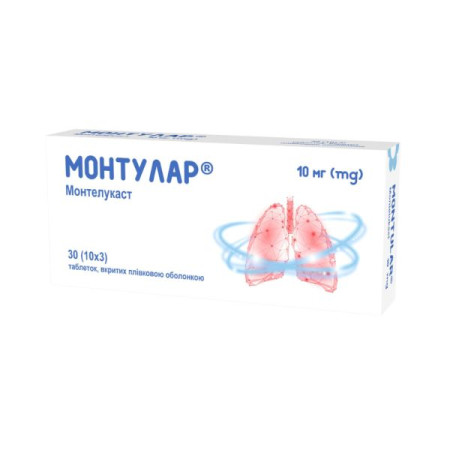Prednisolone ointment 0.5% tube 10 g
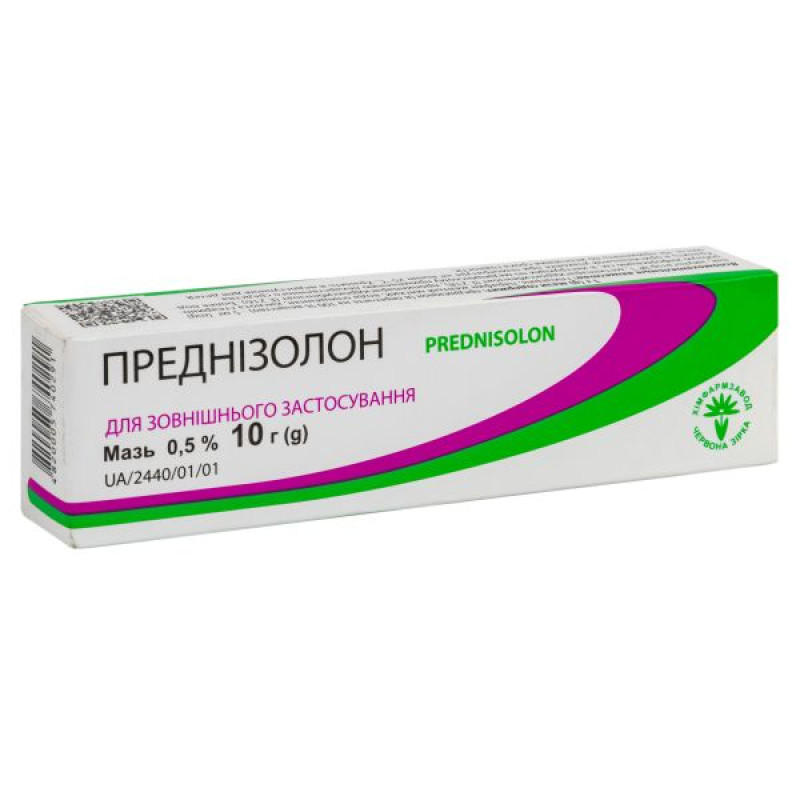
Instructions Prednisolone ointment 0.5% tube 10 g
Composition
active ingredient: prednisolone;
1 g of ointment contains: prednisolone (calculated as 100% substance) – 5 mg;
excipients: glycerin, yellow soft paraffin, purified water, stearic acid, emulsifier No. 1, methyl parahydroxybenzoate (E 218), propyl parahydroxybenzoate (E 216).
Dosage form
Ointment.
Main physicochemical properties: white ointment.
Pharmacotherapeutic group
Corticosteroids for use in dermatology. Prednisolone.
ATX code D07A A03.
Pharmacological properties
Pharmacodynamics
Glucocorticosteroids (GCS) for local (external) application have anti-inflammatory, epidermostatic, antiallergic, immunosuppressive and local anesthetic effects. The anti-inflammatory effect is accompanied by vasoconstriction, reduction of itching and pain at the site of application, impaired migration of lymphocytes and macrophages in the area of inflammation. GCS have an antimitotic and antiproliferative effect. An important aspect of the anti-inflammatory effect of GCS is the stimulation of lipocortin formation, which reduces the formation of arachidonic acid and thereby reduces the formation of mediators of inflammation and allergy. Stabilization of cell membranes plays a significant role in the mechanism of action of GCS. When applied to the skin, it practically does not have systemic glucocorticoid and mineralocorticoid effects.
Pharmacokinetics
after minor absorption from the skin surface binds to plasma proteins, is metabolized in the liver, and is excreted by the kidneys. Violations of the integrity of the skin or an occlusive dressing may increase the absorption of prednisolone through the skin. Prednisolone penetrates the placental barrier and in small quantities penetrates into breast milk.
Indication
As part of the complex therapy of inflammatory and allergic skin diseases of non-microbial etiology: eczema, seborrheic dermatitis, psoriasis, lupus erythematosus, erythroderma.
Contraindication
Wounds or ulcers, bacterial, viral and fungal skin diseases, Cushing's syndrome, chickenpox, herpes simplex, vaccination period, skin manifestations of syphilis, skin tuberculosis, skin tumors, acne vulgaris, acne rosacea (possible exacerbation of the disease), hypersensitivity to the components of the drug, shingles, perioral dermatitis, atrophic dermatitis, skin reactions after vaccination at the site of drug application.
Interaction with other medicinal products and other types of interactions
To prevent skin infections, prednisone is recommended to be prescribed in combination with antibacterial and antifungal agents.
During treatment with the drug, vaccination against smallpox or other types of immunization are not recommended due to the immunosuppressive effect of glucocorticosteroids.
Due to absorption, treatment of large areas of skin or treatment over a long period of time may cause interactions similar to those observed with systemic therapy. However, none of these interactions have been reported to date. If concomitant use of any other medicinal products is necessary, a doctor should be consulted.
Application features
The drug should be used in the lowest doses and for the shortest period necessary to achieve the desired therapeutic effect. If there is a history of psychosis, high doses should be used under strict medical supervision.
With prolonged use of the drug, its sudden withdrawal is dangerous! It may lead to exacerbation of the disease and deterioration of the patient's general condition. Therefore, the drug should be discontinued gradually.
In case of bacterial skin infections and/or fungal lesions, additional special treatment with antibacterial and/or antimycotic drugs is necessary.
Avoid contact with eyes, deep open wounds, and mucous membranes.
Visual disturbances may occur with systemic or topical corticosteroids. If a patient experiences symptoms such as blurred vision or other visual disturbances, they should consult an ophthalmologist to determine possible causes, which may include cataracts, glaucoma, or rare conditions such as central serous chorioretinopathy (CSR), which has been reported with systemic or topical corticosteroids.
In order to increase the effectiveness of therapy, it is possible to use occlusive dressings.
Treatment should be carried out under the supervision of a physician. During treatment, ophthalmologist supervision and blood pressure monitoring are necessary. As with systemic use of KS, glaucoma may occur with their local use (for example, after use in high doses or on a large surface for a long period, in the case of using occlusive dressings or applying to the skin around the eyes).
Treatment with topical preparations for a long period may cause sensitization. In such cases, therapy should be discontinued and appropriate measures taken.
In order to reduce side effects, it is necessary to alternate corticosteroids and non-steroidal drugs. It is necessary to use corticosteroids in short courses and only for the treatment of exacerbations, but not for prevention. When prescribing prednisolone, the daily secretory rhythm of glucocorticosteroids should be taken into account - the rhythm of the release of hormones from the adrenal cortex: in the morning, larger doses are prescribed, in the afternoon - medium, in the evening - small.
Use with caution in immunodeficiency states (including AIDS or HIV infection).
Should not be used for more than 14 days.
The drug contains methyl parahydroxybenzoate (E 218) and propyl parahydroxybenzoate (E 216), which may cause allergic reactions, including bronchospasm.
Ability to influence reaction speed when driving vehicles or other mechanisms
Does not affect.
Use during pregnancy or breastfeeding
The medicine should not be prescribed to pregnant women.
Breastfeeding women are advised to stop either breastfeeding or using the drug, especially at high doses.
Method of administration and doses
For external use, apply the ointment 1–3 times a day in an even, thin layer to the affected area, lightly rubbing into the skin.
To enhance the effect, it is possible to use occlusive dressings on limited areas of inflammation.
The duration of treatment is 6–14 days. The drug should not be used for longer than 14 days.
When prescribing to children over 1 year of age, the total duration of treatment should be limited to 5–7 days and measures that lead to increased resorption and absorption of the steroid (warming, fixing and occlusive dressings) should be excluded.
Children
For children, use on limited areas of the skin for a short course (5–7 days) only under the supervision of a physician. The drug can be used in children aged 1 to 3 years if the expected effect of therapy outweighs the potential risk to the child.
In such cases, it is necessary to limit the total duration of treatment and exclude measures that lead to increased resorption and absorption of the steroid (warming, fixing and occlusive dressings). The drug should not be used on the skin of the face.
In childhood, adrenal suppression may develop more rapidly. In addition, there may be a decrease in growth hormone excretion. When using the drug for a long time, it is necessary to monitor body weight, height, and plasma cortisol levels.
Overdose
Possible increased manifestations of adverse reactions.
With prolonged use of the drug in large doses, symptoms of hypercorticism may appear.
Symptoms: headache, heart failure, hives, rash, severe itching.
Treatment: symptomatic. The drug should be discontinued and a doctor should be consulted.
In severe cases, emergency medical attention is necessary.
In cases of cutaneous atrophoderma associated with overdose with topical application of the drug, treatment should be discontinued. As a rule, symptoms regress within 10-14 days.
Adverse reactions
When using the drug, especially in patients with individual sensitivity to the components of the drug, hyperemia, edema, itching, urticaria, rash, steroid acne, purpura, telangiectasia, burning sensation, irritation, dry skin at the site of application of the drug, pustules, vesicles, pain, papules at the site of application, skin cracks may occur; as in the case of external use of other corticosteroids, such side effects may be observed (frequency not determined), such as thinning of the skin (skin atrophy), the appearance of striae, inflammation of the hair follicles (folliculitis) at the site of application, perioral dermatitis, skin discoloration, bacterial cellulitis, contact dermatitis and allergic skin reactions to any of the components of the drug. In the case of topical use of corticosteroids in diseases that lead to thinning of the cornea or sclera, cases of perforation may be observed. There is information about delayed wound healing, ptosis, mydriasis, blurred vision (see section “Special instructions”). In case of prolonged treatment, the development of secondary infectious skin lesions, atrophic changes, hypertrichosis is also possible. With prolonged use of the ointment, especially on large affected areas of the skin, the development of hypercorticism is possible as a manifestation of the resorptive effect of hydrocortisone. In such cases, the drug should be discontinued.
Expiration date
2 years.
Do not use after the expiry date stated on the packaging.
Storage conditions
Store in the original packaging at a temperature not exceeding 25 °C.
Keep out of reach of children.
Packaging
10 g in tubes. 1 tube in a cardboard pack.
Vacation category
According to the recipe.
Producer
PJSC "Chempharmaceutical Plant "Chervona Zirka".
Location of the manufacturer and its business address
61010, Ukraine, Kharkiv, 1 Hordienkivska St.
There are no reviews for this product.
There are no reviews for this product, be the first to leave your review.
No questions about this product, be the first and ask your question.








